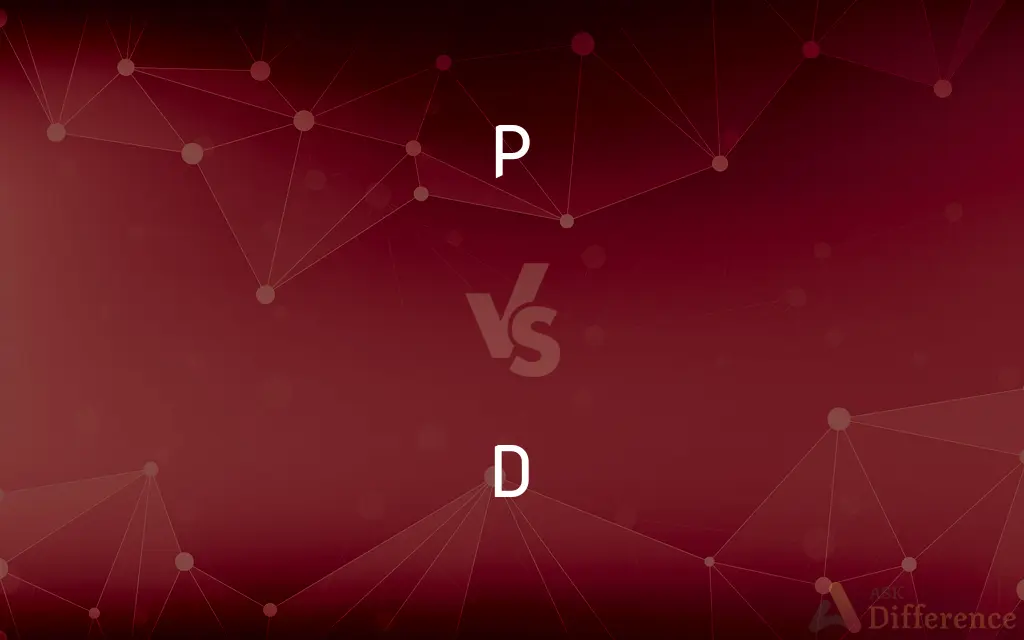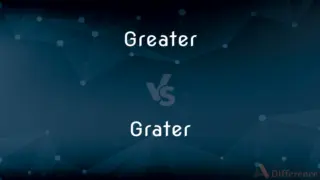P vs. D — What's the Difference?
By Tayyaba Rehman & Maham Liaqat — Updated on April 3, 2024
P is a voiceless bilabial plosive made by blocking airflow using the lips, while D is a voiced alveolar plosive produced by the tongue and the alveolar ridge.

Difference Between P and D
Table of Contents
ADVERTISEMENT
Key Differences
P, as a voiceless bilabial plosive, involves the lips coming together to stop the airflow, then releasing it without vocal cord vibration. D, in contrast, is a voiced alveolar plosive, requiring the tongue to press against the alveolar ridge just behind the upper front teeth, creating sound by vibrating the vocal cords.
The distinction between P and D is not only in their point of articulation but also in their voicing. Voicing is what differentiates sounds like P (voiceless) and B (its voiced counterpart), similar to the relationship between D (voiced) and T (voiceless).
Timing of vocal cord vibration is crucial. For P, the vocal cords do not vibrate during the sound's production, leading to a quieter and sharper sound. Conversely, D's vocal cord vibration results in a louder, more resonant sound.
Articulatory settings for P and D also differ significantly in terms of air pressure and sound resonance. The build-up and release of air pressure in P produce a puff of air, known as aspiration, especially noticeable in languages like English, whereas D's articulation involves less abrupt air pressure changes, creating a smoother sound.
Comparison Chart
Articulation Point
Bilabial (lips)
Alveolar (tongue against alveolar ridge)
ADVERTISEMENT
Voicing
Voiceless (no vocal cord vibration)
Voiced (with vocal cord vibration)
Sound Production
Airflow is completely stopped and then released
Airflow is only partially stopped, allowing for vocal cord vibration
Example Words
Pat, Pop, Spit
Dog, Did, Stand
Phonetic Symbol
[p]
[d]
Compare with Definitions
P
Voiceless bilabial plosive.
The letter P in 'pat' is pronounced with a puff of air.
D
Voiced alveolar plosive.
The letter D in 'dog' vibrates the vocal cords.
P
Represents a sound in many languages.
P is for 'piano,' a universally recognized term.
D
Can denote firmness or decisiveness in speech.
The 'D' in 'decide' emphasizes a strong decision.
P
Can signify silence or secrecy symbolically.
The 'P' in 'psst' is silent, indicating quietness.
D
Central to forming past tense in English.
Added 'D' to 'walk' to form 'walked.'
P
Influences the meaning of words through its presence or absence.
Pair and bare differ only by the initial P.
D
Appears in various positions within words.
Dad, middle, and end all feature the sound D.
P
Found at the beginning, middle, or end of words.
Cap, apple, and stop all contain the sound P.
D
D, or d, is the fourth letter of the modern English alphabet and the ISO basic Latin alphabet. Its name in English is dee (pronounced ), plural dees.
P
P, or p, is the sixteenth letter of the modern English alphabet and the ISO basic Latin alphabet. Its name in English is pee (pronounced ), plural pees.
D
The fourth letter of the modern English alphabet.
P
The 16th letter of the modern English alphabet.
D
Any of the speech sounds represented by the letter d.
P
Any of the speech sounds represented by the letter p.
D
The fourth in a series.
P
The 16th in a series.
D
Something shaped like the letter D.
P
Something shaped like the letter P.
D
D The lowest passing grade given to a student in a school or college.
P
P A hypothesized textual source of certain portions of the Pentateuch that have a formulaic style, contain genealogical lists and descriptions of rituals, and use the name "Elohim" to refer to God.
D
The second tone in the scale of C major or the fourth tone in the relative minor scale.
P
Abbr of postmeaning after
D
A key or scale in which D is the tonic.
P
Abbreviation of per
D
A written or printed note representing this tone.
P
(stenoscript) up
D
A string, key, or pipe tuned to the pitch of this tone.
P
Alternative form of|en|p.}}; {{abbr of page(plural pp)
D
(cricket) declared
P
(UK) penny; pence
D
(crosswords) down
Do you have the answer for 23d?
P
(physics) proton
D
(Malaysia)(informal) already Used to form the perfect tenses. Used in text messages.
Come d.
Done d.
P
(video compression) progressive scan
D
The fourth letter of the English alphabet, and a vocal consonant. The English letter is from Latin, which is from Greek, which took it from PhŒnician, the probable ultimate origin being Egyptian. It is related most nearly to t and th; as, Eng. deep, G. tief; Eng. daughter, G. tochter, Gr. qyga`thr, Skr. duhitr. See Guide to Pronunciation, ?178, 179, 229.
P
Abbr of pee
I'll slurp all that p.
D
The nominal of the second tone in the model major scale (that in C), or of the fourth tone in the relative minor scale of C (that in A minor), or of the key tone in the relative minor of F.
P
(knitting) purl
D
As a numeral D stands for 500. in this use it is not the initial of any word, or even strictly a letter, but one half of the sign (or ) the original Tuscan numeral for 1000.
P
(Internet) pretty
I'm doing p good, how are you?
D
A fat-soluble vitamin that prevents rickets
P
Alternative spelling of p.m.
D
The cardinal number that is the product of one hundred and five
P
The sixteenth letter of the English alphabet, is a nonvocal consonant whose form and value come from the Latin, into which language the letter was brought, through the ancient Greek, from the Phœnician, its probable origin being Egyptian. Etymologically P is most closely related to b, f, and v; as hobble, hopple; father, paternal; recipient, receive. See B, F, and M.
D
The 4th letter of the Roman alphabet
P
A multivalent nonmetallic element of the nitrogen family that occurs commonly in inorganic phosphate rocks and as organic phosphates in all living cells; is highly reactive and occurs in several allotropic forms
D
Denoting a quantity consisting of 500 items or units
P
The 16th letter of the Roman alphabet
Common Curiosities
Do P and D serve the same grammatical functions across languages?
Their functions can vary, but both are fundamental to phonetic structures and word formation in numerous languages.
Can the presence of P or D affect the tempo or rhythm of speech?
Yes, the articulatory characteristics of P and D can influence speech patterns, rhythm, and tempo, particularly in stress-timed languages.
How do children acquire the sounds P and D?
These sounds are among the first consonants children learn to articulate, with D often acquired before P due to its voiced nature.
Is the difference between P and D significant in all languages?
Yes, the distinction is phonemically significant in most languages, influencing meaning and word differentiation.
Can P and D be confused due to their articulation?
In some linguistic contexts, especially for non-native speakers, but their articulation and voicing typically make them distinct.
How does aspiration differ between P and D?
Aspiration is more prominent with P, especially in languages like English, due to the puff of air following the release of the bilabial closure.
Are there any languages without P or D sounds?
While rare, some languages may lack a direct equivalent to either sound, but most have similar bilabial or alveolar consonants.
Can the mispronunciation of P and D lead to misunderstandings?
Yes, incorrect articulation can change word meanings and lead to communication errors, underscoring their phonemic importance.
Are there any words where swapping P and D changes the meaning?
Yes, swapping P and D can result in different words with distinct meanings, such as "pad" and "dad."
Do P and D have equivalents in sign languages?
While sign languages use different modalities, they may use handshapes or movements analogous to P and D's roles in spoken languages.
What role do P and D play in poetic devices or rhyming?
Both consonants contribute to rhyme schemes and alliteration, enhancing the aesthetic and rhythmic qualities of poetry.
How do accents or dialects affect the pronunciation of P and D?
Accents and dialects can influence the aspiration of P and the voicing of D, leading to variation in pronunciation.
Can the distinction between P and D affect speech recognition technology?
Yes, accurate speech recognition requires distinguishing between such phonetic elements to effectively process and understand spoken language.
Do P and D have any symbolic meanings in linguistics or phonology?
Symbolically, they represent basic phonetic distinctions between voiceless and voiced, as well as bilabial and alveolar sounds.
How do P and D contribute to language diversity and complexity?
Their distinct articulatory features and functions enrich phonetic systems, contributing to the phonological diversity across languages.
Share Your Discovery

Previous Comparison
Perfection vs. Excellence
Next Comparison
Greater vs. GraterAuthor Spotlight
Written by
Tayyaba RehmanTayyaba Rehman is a distinguished writer, currently serving as a primary contributor to askdifference.com. As a researcher in semantics and etymology, Tayyaba's passion for the complexity of languages and their distinctions has found a perfect home on the platform. Tayyaba delves into the intricacies of language, distinguishing between commonly confused words and phrases, thereby providing clarity for readers worldwide.
Co-written by
Maham Liaqat













































